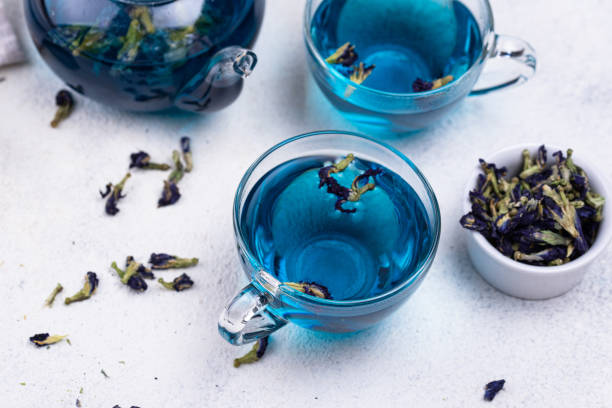Welcome to my article about “How To Make Blue Tea?”. Prepare to discover the enchanting world of blue tea, an enthralling mixture that pleases the senses and offers numerous health advantages. Blue tea, crafted from the delicate petals of the butterfly pea flower (Clitoria Ternatea), is an impressive beverage that has gained significant popularity in the health and wellness community. Its beginnings can be found in Southeast Asia, which has been highly valued for centuries because of its captivating color and potent healing properties.
The butterfly pea flower, the main component of blue tea, is famous for its distinct blue pigment, which turns into a vibrant blue when steeped in hot water. This natural dye, called anthocyanin, is the same compound found in blueberries and red cabbage and is known for its antioxidant properties. Antioxidants are essential for neutralizing free radicals, protecting the body from oxidative stress, and lowering the chances of developing chronic illnesses.
One of blue tea’s most celebrated health advantages is its capacity to improve cognitive function. Acetylcholine in butterfly pea flowers has been linked to enhanced memory and brain function. This makes blue tea a natural nootropic, ideal for individuals seeking a mental boost without the jittery effects of caffeine. Additionally, blue tea is praised for its anti-inflammatory properties, assisting in reducing inflammation and promoting overall well-being.
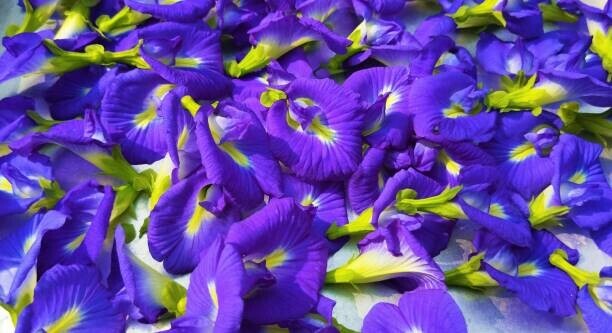
But the benefits do not end there. Blue tea is also a rich source of vitamins and minerals. It contains vitamins A, C, and E, contributing to healthy skin, enhanced vision, and a robust immune system. Blue tea’s relaxing effects make it a wonderful beverage for reducing stress and anxiety, fostering a sense of tranquility and calmness.
Preparing blue tea at home is straightforward yet enchanting. All you need are dried butterfly pea flowers and hot water. Steep the flowers briefly until the water turns a deep blue. For a stunning twist, add a few drops of lemon juice and observe as the tea transforms into a beautiful purple hue due to the change in pH. This uncomplicated brewing method provides a delightful visual display and allows you to relish the tea’s health benefits right from the comfort of your home.
In conclusion, blue tea is more than just a visually stunning beverage; it is a potent potion with health advantages. From enhancing cognitive function to supplying essential vitamins, this dynamic tea is a beautiful addition to any wellness regimen. So why kick off your day with a cup of blue tea and encounter the magic firsthand?
Choosing Your Blue Tea Ingredients: Opting for Quality
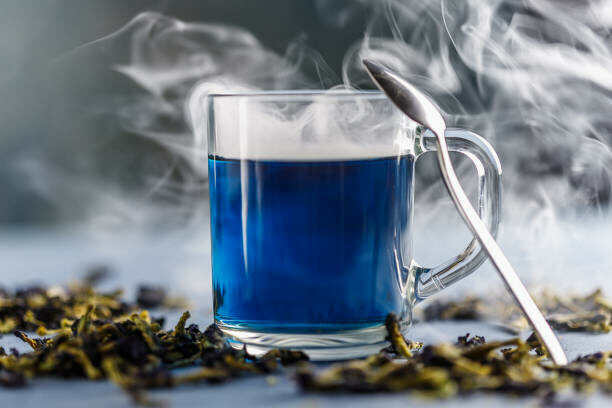
Choosing top-notch ingredients is essential when creating the perfect cup of blue tea. The core of this captivating brew is the butterfly pea flower, which is the secret to unlocking its vibrant color and numerous health advantages. Ensuring that you select the finest butterfly pea flowers will significantly enhance your blue tea experience.
High-quality butterfly pea flowers are distinguished by their vivid blue petals, which signify their freshness and effectiveness. The flowers mustn’t appear wilted or discolored, as these can significantly impact the taste and efficacy of the tea. Opting for premium-grade flowers guarantees the maximum benefits from this potent plant, from its antioxidant properties to its cognitive-enhancing effects.
An essential factor to consider in your selection process is whether to opt for organic or non-organic butterfly pea flowers. Organic butterfly pea flowers are cultivated without the use of artificial pesticides or fertilizers, making them a healthier and more eco-friendly choice. These flowers are less likely to contain harmful residues, ensuring your tea is as pure and beneficial as possible. Although non-organic flowers may be more easily accessible or slightly less expensive, the potential health risks associated with pesticide exposure make organic a worthwhile investment for your well-being.
To enhance the flavor profile of your blue tea, consider incorporating additional ingredients that complement the natural taste of butterfly pea flowers. With its citrusy notes, Lemongrass adds a refreshing kick to the brew, creating a delightful balance of flavors. Adding a hint of honey can bring in a natural sweetness that complements the earthy notes of the tea, enhancing the experience for those who enjoy sweeter flavors.
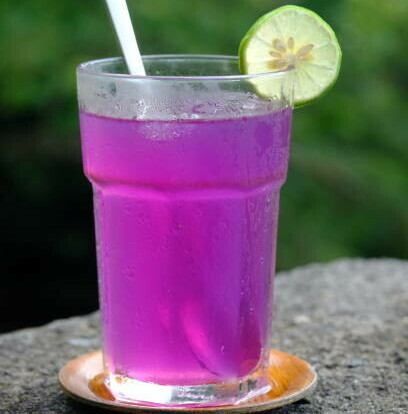
Lemon juice is another excellent addition, enhancing the taste and creating a fascinating color change. The acidity in lemon juice transforms the blue tea into a vibrant purple, adding an element of fun and surprise to your tea routine. How about adding fresh mint leaves to a refreshing and cooling twist? Mint complements the floral notes of butterfly pea flowers while providing a soothing, refreshing aftertaste.
You can elevate your blue tea from a simple beverage to a sensory experience by choosing high-quality butterfly pea flowers and experimenting with complementary ingredients. Whether you prefer the purity of organic flowers or the added complexity of flavors like Lemongrass and mint, the right ingredients will ensure that each sip of your blue tea is as delightful and beneficial as possible.
Step-by-Step Guide to Making the Perfect Cup of Blue Tea
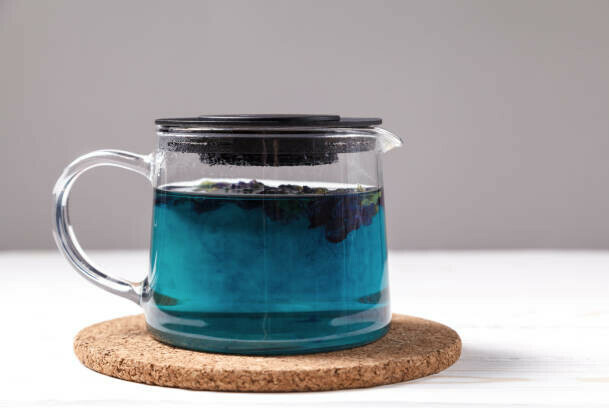
Brewing an excellent cup of blue tea is a delightful and fulfilling experience. Start by gathering the following items: high-grade dried butterfly pea flowers and fresh, purified water. For one standard serving, you will need approximately one teaspoon of dried flowers for every cup of water.
Commence by boiling the water until it reaches about 200°F (93°C). This temperature is perfect for drawing out the vibrant color and beneficial compounds from the butterfly pea flowers without causing bitterness. Once the water has reached the desired temperature, pour it over the dried flowers in your teapot or infuser.
Let tea infuse for 5 to 7 minutes. This time frame is perfect for achieving a rich azure hue and a well-balanced taste. If you desire a more robust infusion, you can extend the steeping time by a few additional minutes. Conversely, for a more delicate flavor, decrease the steeping time slightly. Blue tea’s versatility lies in its ability to be customized to your preferred strength and taste.
As the tea steeps, you’ll observe a magical change as the water transforms into a deep, captivating blue. After the steeping time, strain the tea to remove the flowers, and your blue tea is ready to be enjoyed. Consider adding natural enhancers like lemongrass, honey, or mint leaves for added flavor. Add these ingredients to the teapot with the butterfly pea flowers and adjust the amounts according to your taste.
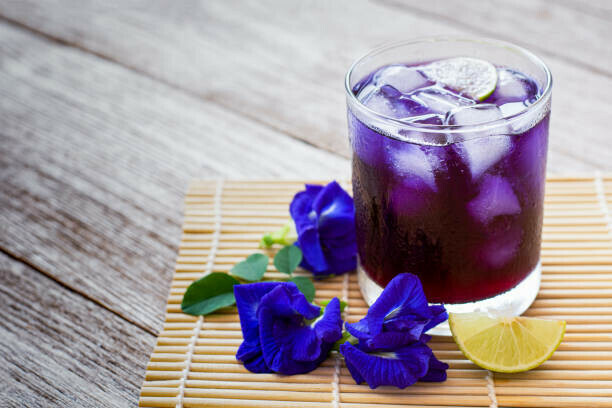
If you’re feeling adventurous, add lemon juice to your blue tea. When the citric acid in the lemon interacts with the anthocyanins in the butterfly pea flowers, it transforms the tea from blue to a beautiful purple. This adds a delightful visual twist and imparts a refreshing citrus flavor.
Adjusting the strength and flavor of your blue tea is simple. For a bolder taste, increase the amount of butterfly pea flowers used or extend the steeping time. To tone down the flavor, use fewer flowers or shorten the steeping period. Try various mixtures and discover the ideal harmony matching your taste preferences.
Creating the perfect cup of blue tea is an art that combines careful attention to detail with a touch of creativity. By following these steps and adapting the process to your preferences, you’ll savor a delicious, visually stunning, and health-boosting beverage every time. Whether sipping it hot or enjoying it iced, blue tea is a distinct and captivating addition to your daily routine.
The Mastery of Presentation: Serving Blue Tea with Aesthetic Appeal
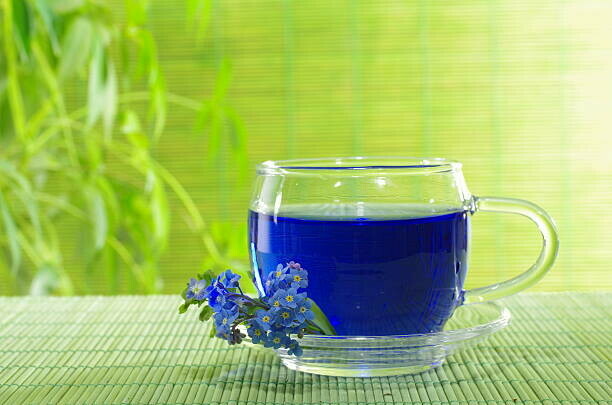
Creating an impressive visual display of blue tea is a skill that can captivate and please your visitors. The intense blue color of blue tea, combined with imaginative serving concepts, transforms this nutritious drink into an unforgettable encounter.
Transparent glassware is one of the easiest yet most efficient methods of presenting blue tea. The precise characteristics of the glass boost the visual impact of the deep blue shade, enabling your guests to appreciate the tea’s charm entirely. Choose elegant teacups or tall, thin glasses to enhance the aesthetic allure. Clear glass exhibits remarkable color and adds a hint of elegance to your tea presentation.
Integrating an aspect of astonishment and wonder, including the color-altering impact of blue tea, by adding acidic elements like lemon juice or lime. Prepare a small jug of freshly squeezed lemon juice and delicately pour it into the blue tea before your guests’ eyes. The tea will change from a vivid blue to a lively purple, generating a mesmerizing visual event. This straightforward technique enhances the taste with a rejuvenating citrus twist and contributes a lighthearted and interactive feature to your tea service.
For an added touch of originality, consider decorating your blue tea with edible blossoms, fresh herbs, or pieces of citrus fruits. A sprig of mint or a portion of lemon not only contributes a burst of color but also harmonizes with the tea’s flavor attributes. Edible blossoms like pansies or violets can drift delicately on the surface, forming a beautiful and social media-worthy presentation. These small particulars ensure your blue tea looks as fantastic as it tastes.
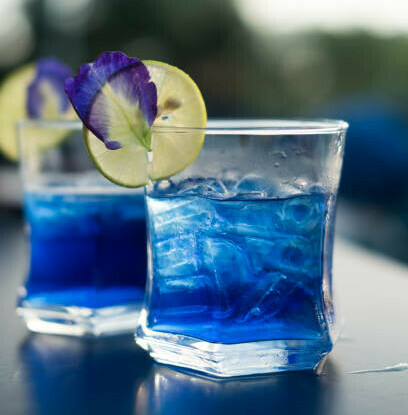
Another inventive concept is offering blue tea over ice for a rejuvenating variation. Fill clear glasses with ice cubes and pour the hot blue tea over them. The ice will gradually melt, diluting the tea into a refreshing beverage ideal for warm weather. For an added decorative aspect, you can also freeze edible blossoms or tiny fruit slices within the ice cubes.
Experimenting with tiers can also contribute a classy allure to your blue tea presentation. Pour a tier of blue tea and let it cool, then carefully add a layer of another complementary beverage, such as a light lemonade or a fruit infusion. The contrasting colors produce an impressively visual layered effect that is certain to amaze.
By concentrating on the presentation, you raise the simple act of offering blue tea into an inventive and delightful experience. These imaginative touches make certain that your guests are not only refreshed by the health advantages of blue tea but also captivated by its visual appeal.
Blue Tea Beyond the Cup: Innovative Uses in Cooking and Mixology
With its vibrant color and gentle taste, blue tea goes well beyond the classical teacup. This adaptable ingredient is a goldmine for food lovers and mixologists seeking to add a pop of natural color and a soft, earthy flavor to their creations.
One of the most exciting ways to use blue tea is as a natural food dye. The intense blue pigment of butterfly pea flowers can turn ordinary dishes into lively masterpieces. Soak the dried flowers in hot water to draw out the color, and then use this infusion to color rice, pasta, or even homemade bread and pastry dough. This natural dye looks excellent and is free from artificial additives, offering a healthier option for you and your loved ones.
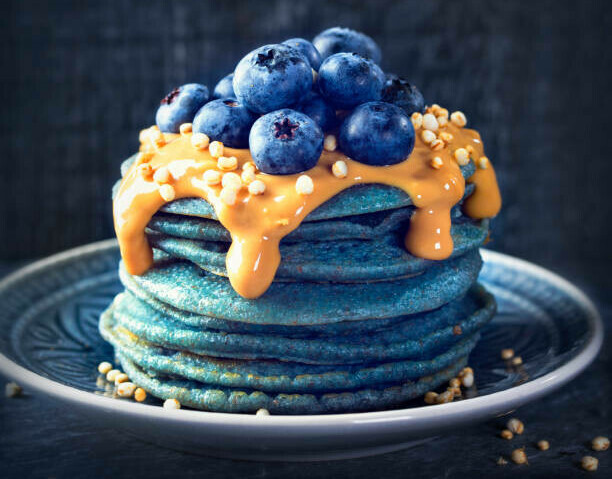
In the culinary world, blue tea can add a unique twist to various recipes. For example, infuse blue tea into syrups to drizzle over pancakes or desserts, creating a visually appealing and tasty topping. Incorporate it into baking by adding blue tea to cake batters or frosting, imparting a lovely blue shade and a subtle floral hint. Blue tea can even be used in savory dishes; imagine blue tea-infused risotto or a delicate seafood sauce. The gentle taste of butterfly pea flowers complements various ingredients, making it a creative inclusion in your cooking skills.
Mixology has also embraced blue tea for its enchanting characteristics. The tea’s ability to change color when mixed with acidic elements makes it a standout in cocktails. Use blue tea in your mixers to prepare a captivating blue margarita or a purple gin fizz. Begin by brewing a concentrated blue tea and allowing it to cool. Then, use it as a base for your cocktails, observing as the vivid blue transforms with lime or lemon juice. This not only creates a mesmerizing visual effect but also adds a layer of depth to the drink’s flavor profile.
Non-alcoholic beverages also benefit from incorporating blue tea. Craft refreshing iced teas, lemonades, or mocktails by blending blue tea with assorted fruits and herbs. For example, blue tea lemonade provides a delightful interplay of colors and flavors, making it an ideal beverage for any occasion.
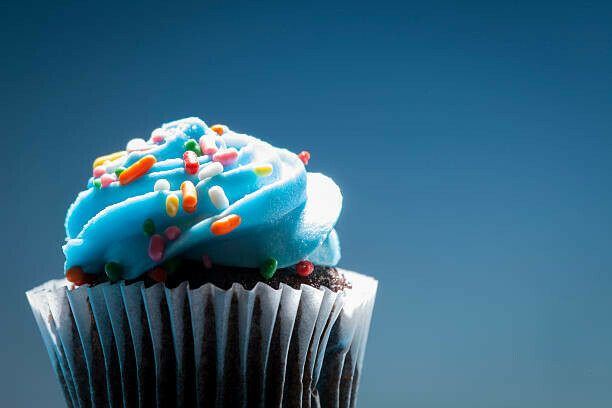
Integrating blue tea into your cooking and mixology unlocks a realm of creativity. Due to its inherent coloring, subtle flavor, and ability to transform, it stands out as an ingredient that elevates your food and beverages’ visual attractiveness and taste. Whether you’re a home chef or a professional mixologist, blue tea presents endless opportunities to surprise and impress your guests.
Thank you for reading my article about “How To Make Blue Tea?”, and I would love to receive your comments down below, in case of any.

